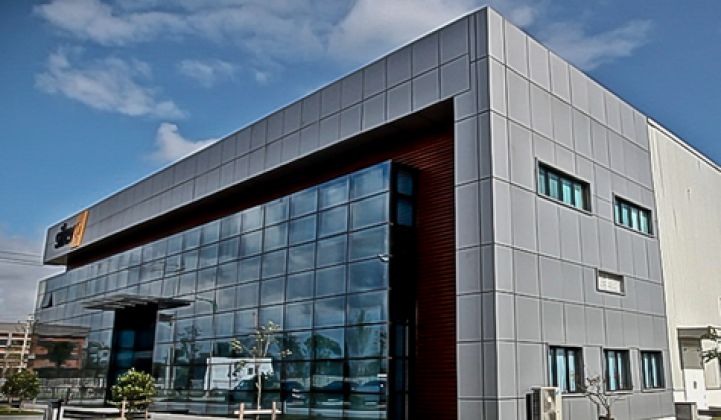SolarCity has gone from its June 2014 acquisition of solar module startup Silevo to today's announcement of what the company claims is production of "the world’s most efficient rooftop solar panel, with a module efficiency exceeding 22 percent."
SolarCity’s panel was measured with 22.04 percent module-level efficiency by the Renewable Energy Test Center. The silicon-based bifacial PV cell combines n-type substrates, copper electrodes, thin-film passivation layers, and a tunneling oxide layer that yields high conversion efficiencies.
SolarCity claims that its module will be "the highest-volume solar panel manufactured in the Western Hemisphere." Production will begin this month at the firm's 100-megawatt pilot facility, but most of the new solar panels will be produced at SolarCity’s 1-gigawatt factory in upstate New York. Full production will be between 9,000 and 10,000 solar panels per day when the Buffalo facility hits full capacity.
SolarCity, the biggest residential solar installer in the U.S., acquired the high-efficiency solar manufacturer Silevo for $168 million in stock, $9 million in cash, and an assumption of $23 million in liabilities. SolarCity could pay out another $150 million in stock if production targets are hit. Founded in 2007 by a team from Applied Materials, Silevo had raised $75 million in funding.
"At a targeted capacity greater than 1 gigawatt within the next two years, it will be one of the single largest solar-panel production plants in the world," wrote Elon Musk, Peter Rive and Lyndon Rive in an earlier SolarCity blog entry. Musk explained that SolarCity plans to install “tens of gigawatts per year” over the next decade. But the company won’t be able to reach its expected scale without a steady supply of modules. “If we don’t do this, we thought there was a risk of not having solar panels in the long term,” he said.
The hybrid concept’s use of oxide as the middle layer evolved from experimental work with metal insulated semiconductor cells carried out by solar energy pioneer Martin Green in Australia in the late 1970s. Silevo competes with high-efficiency panels from SunPower, Panasonic, Sanyo and Suniva. Most vendors apply high-efficiency panels to area-constrained uses (like Japan's rooftops), or, as in the case of vertically integrated SunPower, utility applications. The panels coming off of the SolarCity production lines will be used solely for the company's captive consumption.
Peter Rive, SolarCity co-founder and CTO, called it a "world-record solar panel." Rive noted that the record panel was manufactured on the company's 100-megawatt pilot production line -- the Buffalo factory won't be at full production until 2017.
Rive acknowledged that the 22 percent panel is "on the high end," but also noted that a majority of panels are hitting 21.8 percent. Rive did not furnish efficiency distribution information, but he did state that the firm had developed a method to minimize the delta between cell efficiency and module efficiency with a new module construction technique.
SunPower claims its X-Series panels are the "most efficient panel on the market today" with an efficiency of 21.5 percent. The company also says demand for its X-Series product is "extremely high," with "manufacturing volume [set] to increase more than 300 percent year-over-year." Average cell efficiency across all SunPower lines was close to 23 percent during the quarter, according to the company. A reliable source at SunPower told GTM that 22 percent efficiency panels were already coming off of its line.
A SunPower spokesperson added, "As a company that is leading in providing customers around the globe with world’s most efficient solar panels, SunPower always welcomes others to the efficiency race. It’s great that we all agree - efficiency matters. We’re proud that we’ve been shipping the industry’s highest efficiency solar panels for years and some of our customers are receiving panels with greater than 22 percent efficiency."
Here's the distinction between SolarCity and SunPower: although the SolarCity cell goes through another step to deposit an amorphous silicon layer, Rive expects his module to have a cost of "mid-50 cents per watt," adding, "to me, that is super compelling." Rive went on to say, "We've managed to reach SunPower efficiency at a much better cost." He notes that the SunPower process requires masking, patterning and etching versus SolarCity's deposition process.
Rive said that the 55-cents-per-watt cost is "essential to making sure our cost structure can survive the loss of the ITC [federal Investment Tax Credit]. That's why we're doing this. We're expecting a reduction of 10 cents per watt in balance of system and labor as a result of the high-efficiency panels."
GTM Research solar analyst Jade Jones notes that U.S. module manufacturing capacity is now on track to surpass 3.5 gigawatts by 2018, up from 1.6 gigawatts today. Cell manufacturing capacity could increase to 2 gigawatts, up from 0.7 gigawatts, over the same period, according to GTM Research's PV Pulse.



